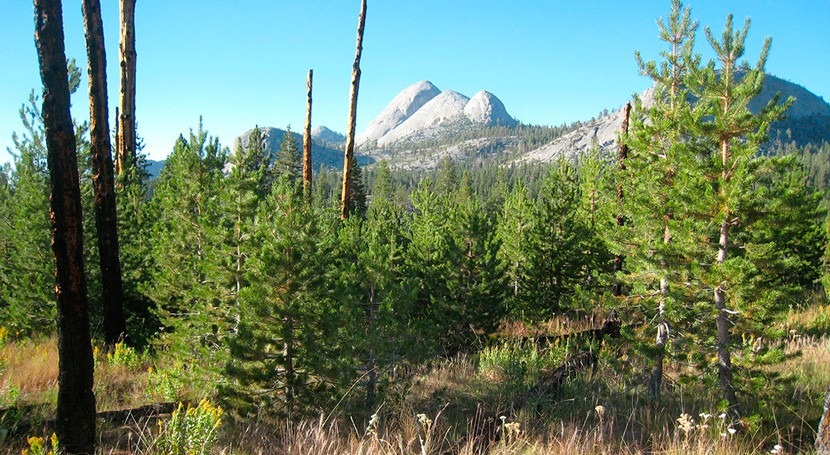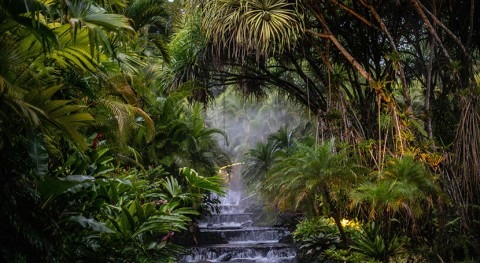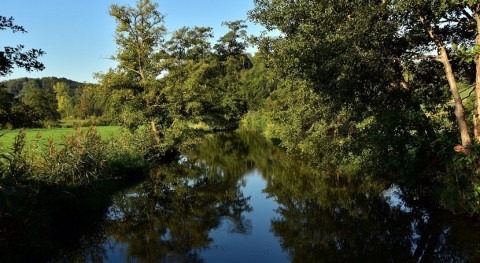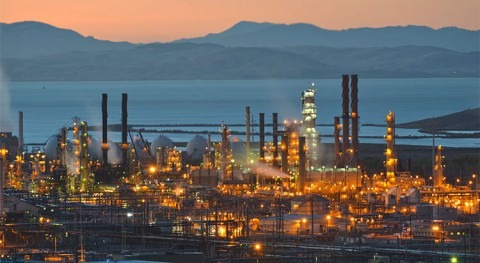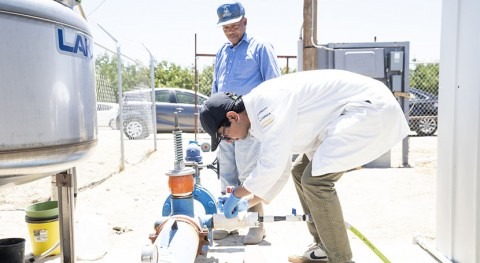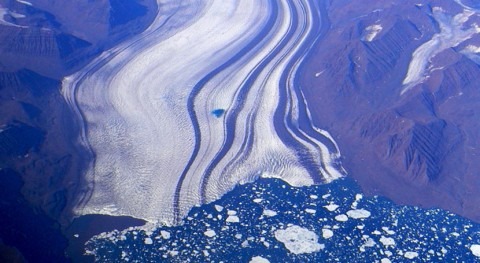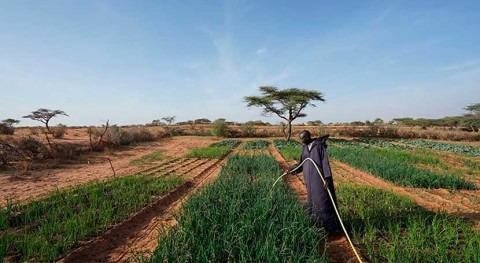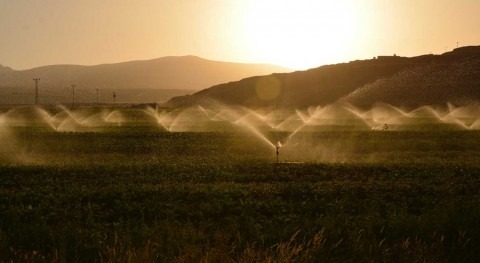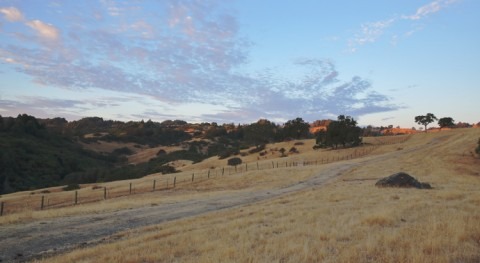For nearly half a century, lightning-sparked blazes in Yosemite’s Illilouette Creek Basin have rippled across the landscape — closely monitored, but largely unchecked. Their flames might explode into plumes of heat that burn whole hillsides at once, or sit smoldering in the underbrush for months.
The result is approximately 60 square miles of forest that look remarkably different from other parts of the Sierra Nevada: Instead of dense, wall-to-wall tree cover — the outcome of more than a century of fire suppression — the landscape is broken up by patches of grassland, shrubland and wet meadows filled with wildflowers more abundant than in other parts of the forest. These gaps in the canopy are often punctuated by the blackened husks of burned trunks or the fresh green of young pines.
“It really is a glimpse into what the Sierra Nevada was like 200 years ago,” said Scott Stephens, a professor of environmental science, policy and management at the University of California, Berkeley, and co-director of Berkeley Forests.
Stephens is the senior author of a new study that gathers together decades of research documenting how the return of wildfire has shaped the ecology of Yosemite National Park’s Illilouette Creek Basin and Sequoia and Kings Canyon National Parks’ Sugarloaf Creek Basin since the parks adopted policies for the basins — at Illilouette Creek in 1972 and Sugarloaf Creek in 1968 — to allow lightning-ignited fires to burn.

Wildfire may be destructive, but it is also necessary for healthy forest regeneration, Stephens said. (UC Berkeley photo by Scott Stephens)
While the prospect of smoke over iconic Half Dome has worried politicians and tourists alike, the work of Stephens and his colleagues demonstrates that allowing frequent fires to burn in these basins has brought undeniable ecological benefits, including boosting plant and pollinator biodiversity, limiting the severity of wildfires and increasing the amount of water available during periods of drought. All these benefits are also likely to make the forest more resilient to the warmer, drier conditions brought by climate change, the research suggests.
“In many ways, fire has successfully been restored to Illilouette, and it has made for a complex mosaic of vegetation with cascading effects on things like water,” said study co-author Brandon Collins, who holds a joint appointment as a research scientist with Berkeley Forests and with the U.S. Forest Service. “In Illilouette, you can have patches of young, regenerating trees from a fire 15 years ago, or areas where a classic understory burn has resulted in big, old, widely-spaced trees. You can even have areas where fire has missed because there’s more moisture, such as adjacent to a creek or on the edge of a meadow. All this complexity can happen in a really short amount of space.”
The study findings arrive in the middle of a critical fire season, when drought conditions throughout the western U.S. have already sparked numerous large wildfires, including the Dixie Fire, which, as of Aug. 8, was the second largest wildfire in California history. While climate change has played a role in increasing the severity of these fires, Stephens said, Illilouette Creek Basin serves as an example of how current forest conditions in the Sierra — largely shaped by decades of fire suppression — are also driving these massive blazes.
“I think climate change is no more than 20 to 25% responsible for our current fire problems in the state, and most of it is due to the way our forests are,” Stephens said. “Illilouette Basin is one of the few places in the state that actually provides that information, because there is no evidence of changes in fire size or in the severity of fires that burn in the area. So, even though the ecosystem is being impacted by climate change, its feedbacks are so profound that it’s not changing the fire regime at all.”

A high severity fire created this patch of wet meadow that is now filled with wild flowers. (UC Berkeley photo by Scott Stephens)
Returning fire to Yosemite
For millennia, wildfires sparked by lightning, or lit by Native American tribes, regularly shaped the landscape of the western U.S., not only causing destruction, but also triggering necessary cycles of rebirth and regeneration. However, the arrival of European colonists in the late 1800s, followed by formation of the U.S. Forest Service in 1905, ushered in an era in which fire was viewed as the enemy of humans and forests alike, and the vast majority of wildfires were quickly extinguished.
By the 1940s and 1950s, a number of forest managers and ecologists had begun to question the wisdom of fire suppression, noting that the practice was eliminating valuable wildlife habitat and increasing the severity of fires by allowing decades of fuel buildup. These fire proponents included A. Starker Leopold, an acclaimed conservationist and professor of zoology and forestry at UC Berkeley, as well as Harold Biswell, a professor at UC Berkeley’s School of Forestry.
In response to a foundational 1963 report led by Leopold, the U.S. National Park Service changed its policy in 1968 to allow lightning fires to burn within special fire management zones — usually remote regions at high elevations — where danger to human settlements was low. Sequoia and Kings Canyon National Parks established the first fire management zone in 1968, followed by Yosemite National Park in 1972.
“I think it was finally recognized that fire is an integral piece of these ecosystems, and there were a few key people who were willing to take the risk of letting these fires happen,” Collins said.
‘It isn’t always clean, and it’s not always nice’
Between 1973 and 2016, Illilouette Creek Basin experienced 21 fires larger than 40 hectares — approximately equal to 75 football fields — while Sugarloaf experienced 10 fires of that size. In Illilouette, the result today is a forest that may look a bit messy to the untrained eye, but it holds a lot of resilience.
“When some people visit Illilouette, they say, ‘Look at all these dead trees!’” Stephens said. “I think we have this idea that forests need to be green all the time and made up with only big trees. But it turns out that no forest can do that. It has to be able to grow young trees and regenerate. Illilouette is doing that, but it isn’t always clean, and it’s not always nice.”
In Illilouette, wildfire has created a more diverse array of habitats for animals like bees and bats, while allowing a variety of plant life to flourish. The detailed history of wildfires in Illilouette has also provided foresters with valuable information on how the impact of one wildfire on landscape and vegetation can influence the trajectory of the next wildfire.
“Since fires are generally allowed to burn freely in Illilouette, we could look at what happens when two fires have burned close to each other: When does the second fire burn into the area that was burned by the first fire, and when does it stop at the previous perimeter?” Collins said. “We found that it really depended on the amount of time that had passed since the first fire. If it had been nine years or under, fires almost never burned into a previous fire perimeter.”
Collins said that Illilouette has also given forest managers a unique opportunity to study how wildfire behaves under a variety of conditions, rather than only at its most dire.
“One of the things that’s kind of perverse about the fire suppression policy is that we actually constrain fires to only burn under the worst conditions. If the fire is mellow, that’s a good time to put it out, and, as a result, they only burn when we can’t put them out,” Collins said. “But by letting these fires burn (in Illilouette), they’re able to experience the full range of weather conditions. On bad days, some of these fires have really put up a pretty good plume. But on the flip side, they also get to burn under more moderate conditions, too, and it makes for really varied effects.”
 Over the decades, frequent fire has transformed the forest ecosystem in Illilouette Creek Basin, creating homes for a more diverse array of animal and plant life. (Image courtesy Gabrielle Boisramé)
Over the decades, frequent fire has transformed the forest ecosystem in Illilouette Creek Basin, creating homes for a more diverse array of animal and plant life. (Image courtesy Gabrielle Boisramé)
Returning fire to Illilouette has also had the somewhat counterintuitive impact of increasing the availability of water in the basin, a key finding as California weathers yet another year of extreme drought.
Study co-author Gabrielle Boisramé, an assistant research professor at the Desert Research Institute in Nevada, began studying water in Illilouette as a Ph.D. student in environmental engineering at UC Berkeley. Her simulations and measurements indicate that small gaps in the tree canopy created by wildfires have allowed more water from snow and rainfall to reach the ground, while also reducing the number of trees competing for water resources. As a result, soil moisture in some locations in Illilouette increased as much as 30% between 1969 and 2012, which likely contributed to very low tree mortality in the basin during the drought years of 2014 and 2015.
Measurements also indicate that streamflow out of Illilouette Creek Basin has increased slightly since the managed wildfire program began, while streamflow out of other similar watersheds in the Sierras have all decreased. Boosting the amount of water that flows downstream is likely to benefit both the humans and the aquatic ecosystems that depend on this precious resource.
“There’s more and more work being done that examines the effects of fire on hydrology, but most of the other research is looking at the effects of catastrophic fires that burned up an entire forest,” Boisramé said. “As far as we know, we’re the only ones in the western U.S. studying a restored fire regime, where we’re not just looking at one individual fire, but a number of fires of mixed severity that have occurred over natural intervals of time. There just aren’t that many places to study the long-term effects of these repeated wildfires because Sugarloaf and Illilouette were the first areas in California — really the first western mountain watersheds — where they started allowing fires to burn most of the time.”
Fighting for fire
Most U.S. national parks now practice some form of fire use, rather than full fire suppression, and in 1974, the National Forest Service also changed its policy to also allow some fires to burn on its lands, although areas of fire use are rare in this agency. However, these federal fire use policies have struggled to gain a foothold, largely because of the inherent risks involved in managing wildfire.
Even in Sugarloaf Creek Basin, where many fires have been allowed to burn, there has also been significantly more fire suppression than in Illilouette, the study found. As a result, the ecological benefits in Sugarloaf are not as pronounced as those in Illilouette.
“I think one of the key things to recognize is that the landscape in Illilouette was already somewhat unique, partly because it is at slightly higher elevation than a lot of the forests we manage,” Collins said. “As a result, it already had a mix of vegetation with patches of meadows and rock, and I think maybe that gave managers a little more ease in letting fire happen there. It doesn’t have the potential to really push off a giant megafire because it lacks the continuity that some of these other areas have.”

The lightning-sparked Empire Fire burned in Illilouette Creek Basin for nearly four months during the late summer and fall of 2017. (UC Berkeley photo by Scott Stephens)
While both naturally-sparked fires and prescribed burns could help large swathes of the Sierra forest become more resilient to both drought and high severity fire, opposition to national “let it burn” policies in California remains strong, with state and local fire agencies often favoring the safety of fire suppression.
Collins and Stephens both acknowledge that the current fuel density in much of the Sierra, mixed with the hotter, drier conditions already triggered by climate change, has made managing wildfire even riskier than it was when forest managers started allowing fires to burn in Yosemite in 1972. However, they argue, fire suppression will never succeed in the long term, because the longer that forest fuel sources are allowed to build up, the more likely it becomes that wildfires will turn catastrophic when they are finally sparked.
“In order to actually allow this to happen, political and public institutions need to be willing to accommodate risk, because there will be some unpredictability. There are going to be fires that get larger, and more severe burning in places that have had very little fire for a century or more,” Stephens said. “We can’t guarantee that Illilouette is going to be the new outcome, because it started when climate change was not nearly as severe. So, political institutions will have to accommodate that, or the first fire that doesn’t do exactly what we hope will shut down the whole program.”
Collins and Stephens also advocate for more aggressive prescribed burning and restoration thinning throughout the Sierra to help get the forests to a place where lightning-sparked fires can be allowed to burn more safely.
Stephens credits strong, early leadership at Yosemite — including that of study co-author Jan W. van Wagtendok, who received a Ph.D. from UC Berkeley in 1972 and went on to serve as a research scientist at Yosemite for most of his career — for taking the huge risk of launching the program and allowing early fires to burn in the park.
“It’s been 50 years now, but I think what we’ve learned helps us understand what is possible,” Stephens said. “We have 10 to 20 years to actually change the trajectory of the forest ecosystems in our state, and if we don’t change them in 10 or 20 years, the forest ecosystems are going to change right in front of our eyes, and we’re just going to be passengers. That’s why it’s so important to continue this work.”
Previous funding from the U.S. Joint Fire Science Program, UC ANR Competitive Grants Program, and the National Science Foundation’s Critical Zone Collaborate Network (award number 2011346) supported the research in this paper.
Study co-authors also include Sally Thompson of the University of Western Australia; Lauren C. Ponisio of the University of Oregon, Eugene; Ekaterina Rakhmatulina, Jens Stevens and Zachary L. Steel of UC Berkeley; and Kate Wilkin of San Jose State University.


